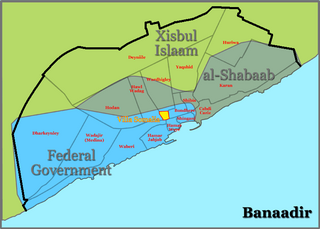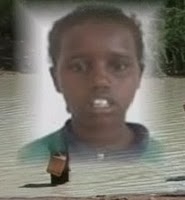Related Research Articles

The Somali Armed Forces are the military forces of the Federal Republic of Somalia. Headed by the president as commander-in-chief, they are constitutionally mandated to ensure the nation's sovereignty, independence and territorial integrity.

Children have been recruited for participation in military operations and campaigns throughout history and in many cultures.

The Somali Civil War is an ongoing civil war that is taking place in Somalia. It grew out of resistance to the military junta which was led by Siad Barre during the 1980s. From 1988 to 1990, the Somali Armed Forces began engaging in combat against various armed rebel groups, including the Somali Salvation Democratic Front in the northeast, the Somali National Movement in the northwest, and the United Somali Congress in the south. The clan-based armed opposition groups overthrew the Barre government in 1991.

The Ethiopian occupation of Somalia, also called the Ethiopian invasion of Somalia or the Ethiopian intervention in the Somali Civil War, was an armed conflict in Somalia that lasted from 2006 to 2009. It began when military forces from Ethiopia, supported by the United States, invaded Somalia to depose the Islamic Courts Union (ICU) and install the Transitional Federal Government (TFG). The conflict continued after the invasion when an anti-Ethiopian insurgency emerged and rapidly escalated. During 2007 and 2008, the insurgency recaptured the majority of territory lost by the ICU. At the start of 2009 Ethiopian troops withdrew from Somalia, but became re-involved several years later to counter the growing strength of Al-Shabaab.
Various international and local diplomatic and humanitarian efforts in the Somali Civil War have been in effect since the conflict first began in the early 1990s. The latter include diplomatic initiatives put together by the African Union, the Arab League and the European Union, as well as humanitarian efforts led by the Office for the Coordination of Humanitarian Affairs (OCHA), UNICEF, the World Food Programme (WFP), the Puntland Maritime Police Force (PMPF) and the Somali Red Crescent Society (SRCS).

The 2009 timeline of events in the Somalia War (2006–2009) during January 2009 is set out below. From the beginning of February the timeline of events in the Somali Civil War (2009–present) is set out following the conclusion of the previous phase of the civil war.

The Somali Civil War (2009–present) is the ongoing phase of the Somali Civil War which is concentrated in southern and central Somalia. It began in late January 2009 with the present conflict mainly between the forces of the Federal Government of Somalia assisted by African Union peacekeeping troops and al-Qaeda aligned al-Shabaab militants.

The Battle of Mogadishu (2009) started in May with an Islamist offensive, when rebels from al-Shabaab and Hizbul Islam attacked and captured government bases in the capital of Mogadishu. The fighting soon spread, causing hundreds of casualties, and continued on at various levels of intensity until October. The battle's name usually includes the year, when referenced, in order to distinguish it amongst the nine major Battles of Mogadishu during the decades long Somali Civil War.

A series of battles in Hiraan, Shabeellaha Dhexe and Galgudug, between rebels of al-Shabaab and Hizbul Islam and Somali government forces and ICU militants loyal to the government, erupted during spring 2009. The fighting led to al-Shabaab capturing major government strongholds and Ethiopian forces re-entering Somalia and setting up bases in Hiraan. There was a halt in fighting during a government offensive in Mogadishu, which started on May 22.

Ahlu Sunna Waljama'a (ASWJ) is a Somalia-based paramilitary group consisting of moderate Sufis opposed to radical Salafism. The group opposes hardline capital punishment, stonings, and limb amputations advocated by extremist interpretations of Islam, as well as laws banning music and khat. The group seeks to protect religious shrines from demolition.

The Battle of Mogadishu (2010–11) began on 23 August 2010 when al-Shabaab insurgents began attacking government and African Union Mission to Somalia (AMISOM) positions in the Somali capital of Mogadishu. Al-Shabaab began its offensive after its spokesman said the group was declaring a "massive war" on troops sent by AMISOM, describing its 6,000 peacekeepers as "invaders". In December 2010 the number of AMISOM troops was increased to 8,000 and later to 9,000. The battle's name usually includes the years, when referenced, in order to distinguish it amongst the nine major Battles of Mogadishu during the decades long Somali Civil War.
Capital punishment is a legal criminal penalty in Somalia, a nation in East Africa. Legally sanctioned executions of the death penalty in Somalia are carried out by shooting, in accordance with the 1962 Somali Penal Code and the Military Penal Code. Sharia and Islamic tribunals are recognised in Somalia in parallel with the civil law: these would have the authority to order execution by other means, such as beheading and stoning. Since at least the start of the 21st century, all executions by such methods have been applied ad-hoc, without official sanction, by non-state insurgent militias, in the context of an unstable government, and the ongoing civil war. A number of these extrajudicial executions have violated sharia legal principles and appear to have a conflict-related tactical aim of inciting fear amongst civilians. Both officially sanctioned and extrajudicial executions by firing squad often occur in public.

This is a 2011 timeline of events in the Somali Civil War (2009–present).

Operation Linda Nchi had the Kenya Defence Forces enter southern Somalia beginning in 2011. The Kenyan government declared the operation completed in March 2012, but its forces then joined AMISOM in Somalia.

This is a 2012 timeline of events in the Somali Civil War (2009–present).

The stoning of Aisha Ibrahim Duhulow was a public execution carried out by the Al-Shabaab militant group on 27 October 2008 in the southern port town of Kismayo, Somalia. Duhulow's father and aunt stated that she was a 13-year-old girl and that she had been arrested and stoned to death after trying to report that she had been raped. Initial reports had stated that Duhulow was a 23-year-old woman found guilty of adultery; she was, however, under the age of marriage eligibility. The execution took place in a public stadium attended by about 1,000 bystanders, several of whom attempted to intervene but were shot by the militants.

During the first and second civil conflicts which took place in the Democratic Republic of the Congo (DRC), all sides involved in the war actively recruited or conscripted child soldiers, known locally as Kadogos which is a Swahili term meaning "little ones". In 2011 it was estimated that 30,000 children were still operating with armed groups. The United Nations Organization Stabilization Mission in the Democratic Republic of the Congo (MONUSCO), released a report in 2013 which stated that between 1 January 2012 and August 2013 up to 1,000 children had been recruited by armed groups, and described the recruitment of child soldiers as "endemic".

Child soldiers in Africa refers to the military use of children under the age of 18 by national armed forces or other armed groups in Africa. Typically, this classification includes children serving in non-combatant roles, as well as those serving in combatant roles. In 2008, it was estimated that 40 percent of child soldiers worldwide were in Africa, and the use of child soldiers in armed conflict was increasing faster than any other continent. Additionally, average age of children recruited as soldiers appears to be decreasing. As of 2017, the UN listed that seven out of fourteen countries recruiting and using child soldiers in state forces or armed groups were in Africa: Central African Republic, Democratic Republic of the Congo, Mali, Nigeria, Somalia, South Sudan, Sudan.

This is a 2013 timeline of events in the Somali Civil War (2009–present).

This is a 2010 timeline of events in the Somali Civil War (2009–present).
References
- ↑ Graeme 2010.
- ↑ Rosen 2012, p. 49.
- ↑ Rosen 2012, p. 50.
- ↑ Tancos 2012.
- ↑ Kagari 2012.
- ↑ Guterres 2017.
- ↑ Johnson 2017.